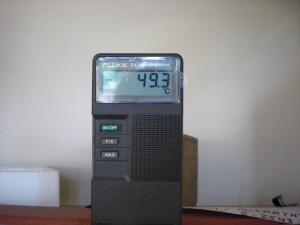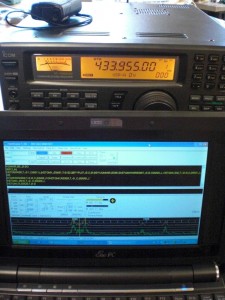Well, here’s another update on that class experiment I’m doing. I got to go into one of the labs yesterday and run thermal testing on my team’s experiment. Overall it went pretty well despite a few errors.
Through the process of thermal testing, we cycle the board from room temperature, to +50 C (122 F), down to -50 C (-58 F), back to +50 C, and then let it come down to room temperature. These temperature fluctuations are designed to make the board, components, and solder joins expand and contract as much as possible. This allows us to make sure we have really solid solder joints. Here’s a picture of a thermometer telling us that it’s freaking cold!
All the meanwhile, I had the radio I will be using to receive my data sitting on a table near the thermal test chamber, picking up the transmitted data from the experiment to make sure it actually runs the whole time. Here’s a picture of that with my laptop receiving data.
Unfortunately, the test did not go as flawlessly as I had hoped, which means it wasn’t flawless. There were some errors, and there were some things I realized we need to consider.
One of them was a software error that I accidentally put in. A while ago I realized that the software couldn’t handle a negative temperature reading. So I corrected the software, but the day of the testing I accidentally loaded the old version on the board, so as soon as the temperatures got negative, I could only read zeros from the on board temperature sensor.
Secondly, There was an error that happened somewhere around -40 C where the chip stopped transmitting data. After warming the chamber back up, the chip began transmitting again, but the run time clock had been reset. So we decided it had to be either the chip, or the power with issues. Upon inspection of the board, I had neglected to fully seat the chip in it’s socket. This was likely our issue there.
Third and most important was our ozone sensor stopped responding at approximately -15 C. This was half expected, as we knew the ozone sensor wasn’t rated that low, however, we’d like to be able to get data points while we’re up there, so we’re thinking about using some pocket hand warmers and strapping them around it to try and keep it warm.
Beyond that, everything seems to be working fine. My lithium battery charger broke the other day, so I’ve rigged one since I don’t have time to order one before launch this Saturday. It seems to be working pretty well, and I actually might make a faster and more permanent version as the replacement for the broken one, rather than buying one.
The last thing I’ve done is slow down the data rate on my radio link, as during testing the transmitter was in a large metal box which made receiving signals harder (like it would be if it was 50-150 miles away). The slowed data rate makes each individual tone last a little longer, and makes it easier to decode.


